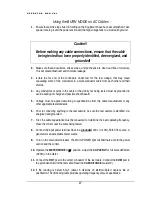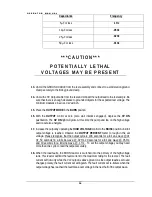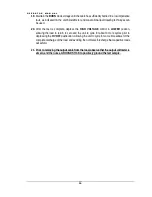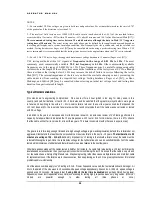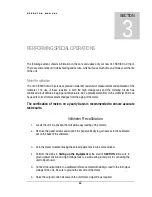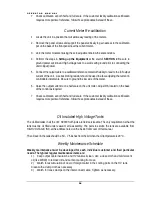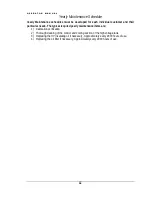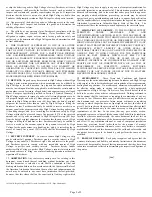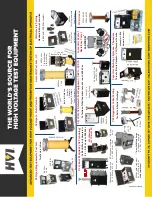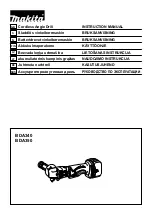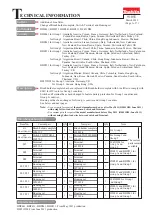
O P E R A T O R M A N U A L
21
NOTES
1—For sinusoidal VLF the voltages are given in both rms and peak values. For a sinusoidal waveform the rms is 0.707
of the peak value if the distortion is less than 5%.
2—The results of field tests on over 15000 XLPE cable circuits tested showed that ~68% of the recorded failures
occurred within 12 minutes, ~89% within 30 minutes, ~95% after 45 minutes, and 100% after 60 minutes (Moh [B17]).
The recommended testing time varies between 15 and 60 minutes, although the data in Moh
[B17]
suggest a
testing time of 30 minutes.
The actual testing time and voltage may be defined by the supplier and user and depend on
the testing philosophy, cable system, insulation condition, how frequently the test is conducted, and the selected test
method. Testing databases or Eager et al. [B7] may be consulted when choosing a preferred testing time. When a VLF
test is interrupted, it is recommended that the testing timer be reset to the original time when the VLF test is restarted.
3—For a 0.1 Hz VLF test voltage, the suggested maintenance voltage duration is 15 minutes (Eager et al. [B7]).
VLF testing methods utilize AC signals at
frequencies in the range of 0.01 Hz to 1 Hz
. The most
commonly used, commercially available
VLF test frequency is 0.1 Hz
. Other commercially available
frequencies are in the range of 0.0001 Hz to 1 Hz. These frequencies may be useful for diagnosing cable
systems where the length of the cable system exceeds the limitations of the test system at 0.1 Hz, although
there is evidence that testing below 0.1 Hz may increase the risk of failure in service following the test in
Moh [B17]. The internal impedance of the test set can limit the available charging current, preventing the
cable under test from reaching the required test voltage. Testing databases; Eager et al. [B7]; or Baur,
Mohaupt, and Schlick [B5] may be consulted when selecting an initial test voltage level and testing time
duration for a particular cable length.
Typical Recommendations
[It comes down to engineering compromises. One can test for an hour (which is too long for many users in this
country) and catch all defects, or test for 25 – 30 minutes and be satisfied that the great majority of defects were grown
to failure and be willing to live with a 2 – 3% in-service failure rate over the next few years on cables that passed the
VLF test. Even at 3%, the in-service failure rate would be less by multiples than if the cable was never tested or tested
with DC voltage.
In addition to the years of European and North American research, an extensive review of VLF testing performed in
Japan by Furukawa Electric indicated that if a cable passes a VLF test at 3Vo for 15 minutes, there is a 97% chance
that the cable will not fail in service for at least three years. This data is consistent with other users experiences.]
The goal is to test for a long enough time and at a high enough voltage to grow existing insulation defects thru to failure but not
aggravate minor defects that would not have resulted in an in-service failure in the next 5 – 10 years. The test duration is 30
minutes at a voltage of 2.5 - 3Vo at 0.1 Hz. Very important in VLF testing is that should a failure occur, the cable must be
retested following the repair. Once the cable holds voltage for the full duration, one can be satisfied that 95+% of the cables
tested will not contain any further defects that will result in in-service failures in the next few years.
Other data and knowledge of the cables tested is helpful. For instance, if a cable fails twice during a VLF test, both times the
insulation and not accessories, then you may want to consider not continuing the test if it is known that the cable is very old and
it or like cables have a history of high failure rate. Maybe stop testing, rather than cause multiple failures, and mark that cable
for replacement soon. If the failures are to the accessories, then keep testing, as the VLF is a great splice checker for material
problems and/or workmanship.
All of the above numbers apply to VLF testing at 0.1Hz. If lower frequencies are used, the test duration should be longer. At
0.1Hz, the period of the sine wave is 10 seconds with a peak voltage applied every 5 seconds. At 0.05 Hz, a peak voltage is
applied every 10 seconds. We suggest that if using 0.05 Hz the test time be doubled and perhaps tripled if using lower
frequencies. Lower test frequencies are
sometimes necessary for testing highly capacitive loads; very long cables. (Most HVI
models are powerful enough to allow testing all three phases at once.)











